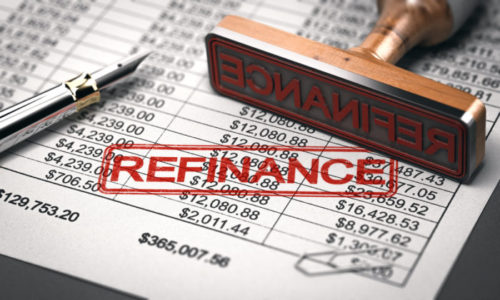Consumers take out personal loans for a variety of reasons, but financial situations change and over time the loan terms that were agreed upon may not work for the individual anymore. Instead of paying off the loan with your credit card, or defaulting on your loan, you can refinance your personal loan to better suit your financial status.
Table of Contents
What Does It Mean to Refinance a Personal Loan?
When you refinance a personal loan, you are essentially swapping one loan for another loan in order to pay off the current loan that you have. Your reasons for doing so may vary, but people typically refinance to obtain better loan terms such as a better interest rate or a lower monthly payment.
How to Refinance a Personal Loan
Refinancing a personal loan is very similar to refinancing your mortgage. It is also an almost identical process to when you applied for the original loan. Since you already have one loan, there are specific things to consider throughout the process. Follow the steps below to effectively refinance your personal loan.
1. Check Your Credit Score
The first step to applying for any type of loan should always be taking a look at what your credit score is. You can request a credit score from each of the three credit bureaus — Experian, Equifax, and TransUnion. A good credit score can help you qualify for better interest rates.
For refinancing a personal loan, you want to be sure that your current credit score is higher than your credit score when you applied for the original loan. If your credit score is the same, or worse, you could have difficulty getting better loan terms.
Be sure to read your credit report carefully to dispute any sort of mistake(s). Addressing and correcting these mistakes can potentially improve your credit score.
2. Talk With Your Lender
Before you shop around for other lenders, you should reach out to your lender to talk about the possibility of them refinancing your personal loan. You already have an established relationship with the lender, so they have insight into your credit history and first-hand experience with how likely you are to make your payments.
If you cannot come to an agreement, this is also a good time to ask about any early payoff fees that may exist. If there are hefty early payoff fees, refinancing your personal loan may not be worth it.
3. Shop Around
Be sure to thoroughly research and shop around for different lenders. You can shop at banks, or scour the web in search of the best online lender.
Gather information surrounding rates and terms from an array of lenders and compare them in order to choose the best option for refinancing your personal loan. Your research should include interest rates, loan duration, and any origination fees.
You can also look at reviews through the Better Business Bureau to gain an understanding of the reputation associated with the lender. This will give you a glimpse into other borrowers’ experiences with lenders to help make your decision simpler.
A new loan isn’t always the best option just because you are getting a better interest rate. Sometimes refinancing your loan can incur extra fees, or it can extend the life of the loan. If you extend the life of the loan for a lower interest rate, you may actually end up paying more in interest over the life of the new loan.
Some personal loans have prepayment penalties in place that could end up negating your refinancing efforts. Be sure to shop around extensively, read the fine print, and take your time.
4. Apply
Once you have gathered enough information shopping for lenders, the next step is applying for a loan. The application process and requirements may vary between lenders.
Make sure to take your time filling out the application to avoid any inaccurate information that may slow down the lender’s evaluation of your application. Be sure to gather the necessary documentation — the documentation requirements can vary depending on the lender, but they generally include:
- A valid form of ID;
- Social Security number;
- Your address and proof of residency (utility bill, mortgage papers, house deed);
- Your contact information;
- Proof of employment/income (pay stubs, bank statements).
5. Wait for Approval
After you apply, you simply need to wait for approval. The specific amount of time it takes to get approved will vary depending on the lender and their vetting process. It can take anywhere from a day to a full month, but typically it takes around a week to process a loan application.
6. Pay Off Your Old Loan
After you have been approved and receive funding, you should immediately pay off the balance on your old loan to avoid any unnecessary interest accruing. Keep an eye on your old account to ensure that they have received your payment and that your account has been closed. If there are any discrepancies, reach out to your lender sooner rather than later.
Advantages of Refinancing a Personal Loan
There are multiple advantages to refinancing your personal loan to take into consideration:
- Lower interest rates: If you have made strides towards improving your credit score, or the market rates have dropped, refinancing your loan can potentially lower your interest rates. Additionally, if you currently have a variable interest rate, you may be able to shop for a lender that offers fixed-rate interest so that the interest that you pay doesn’t change as the market does;
- Lower monthly payments: If you are struggling to make your monthly payment amounts then refinancing your loan can give you the chance to extend the length of your loan — lowering your monthly payment amount;
- Different loan lengths: If you qualify, you may be able to shorten the length of your loan — helping you get rid of your debt faster without worrying about prepayment penalties.
Disadvantages of Refinancing a Personal Loan
There are multiple disadvantages to refinancing your personal loan to consider as well:
- Fees: Whenever you take out a new loan, there is potential for origination fees, application fees, and annual fees. As mentioned above, there can also be prepayment penalties involved with refinancing;
- Paying more in interest: When you extend the loan period, it generally ends up costing you more money in interest over the life of the loan;
- Credit inquiries: When you apply for a loan, lenders have to perform a credit inquiry. Applying for a personal loan generally means a hard inquiry, which can decrease your credit score.
Image Source: https://depositphotos.com/





